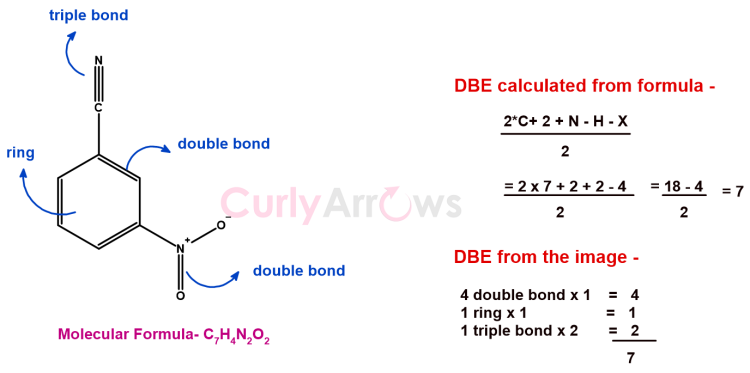Pre-requisite Reading: Identifying single bond, double bond, triple bond, saturation, and unsaturation.
The DBE calculation uses the general molecular formula to find the presence of unsaturation in a compound. The unsaturation is calculated in levels or degrees. The lowest degree of unsaturation (DOU) indicates minimum unsaturation; there is the least loss of hydrogens to form pie bonds or cyclic rings like in cycloalkanes.
General Molecular Formula
CnH2n+2 CnH2n and CnH2n-2
saturated unsaturated
The formula for calculating DBE is -
DOU/DBE= (2C + 2 + N -H - X)/2
The formula ignores heteroatoms like oxygen and sulfur from the molecular formula in the calculations; however, it considers halogen and nitrogen.
Steps to calculate DBE
Calculate using the number of Carbon (C), Hydrogen (H), Nitrogen (N), and Halogen (X) from the molecular formula as shown below-
a) For Molecular formula C5H10 = (2C + 2 + N -H - X)/2 = (2 x 5 + 2 - 10)/2 = (12-10)/2 = 1
b) For Molecular formula C2H3OCl = (2C + 2 + N -H - X)/2 = (2 x 2 + 2 - 3 - 1)/2 = (6-4)/2 = 1
c) For Molecular formula C9H10O = (2C + 2 + N -H - X)/2 = (2 x 9 + 2 - 10)/2 = (20-10)/2 = 5
The DBE calculation does not give the exact number of the molecule’s double bond, triple bond, or ring present but offers possibilities.
For instance, a few possible combinations of the DBE values and the type of unsaturation that could be present in the compound are-
DBE Value 1 = one pie bond or a ring
DBE Value 2 = two pie bonds or one triple bond or two rings or one pie bond + one ring (a triple bond has two pie bonds)
DBE Value 3 = three pie bonds or one triple bond + one double bond or three rings or two rings + one double bond or one ring + 2 double bonds
DBE value of 4 = four pie bonds, four rings, three pie bonds + one ring (a classic example is benzene), two pie bonds + two rings, one pie bond + three rings, two triple bonds, one triple bond + two double bond, one triple bond + two rings.

Therefore, the DBE value provides incomplete information.
More information is needed to deduce the actual structure of the molecule, which can be obtained from laboratory experiments and analytical techniques like NMR (nuclear magnetic resonance spectroscopy), IR (infrared spectroscopy), and Mass spectroscopy.
A few examples wherein the structure of the molecule is predicted from DBE value and laboratory experiments are-
Practice Problems
a) Calculate the Double Bond Unsaturation from the Molecular Formula (quiz)
b) Predict the Value of Double Bond Unsaturation from the Structure (quiz)
.png)